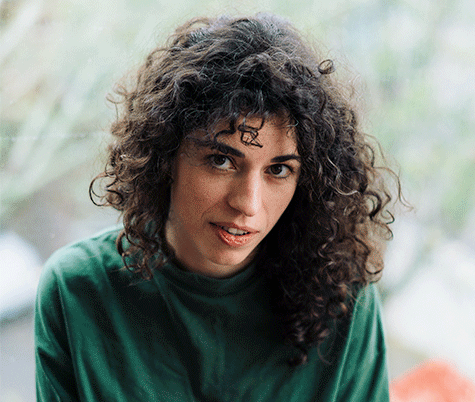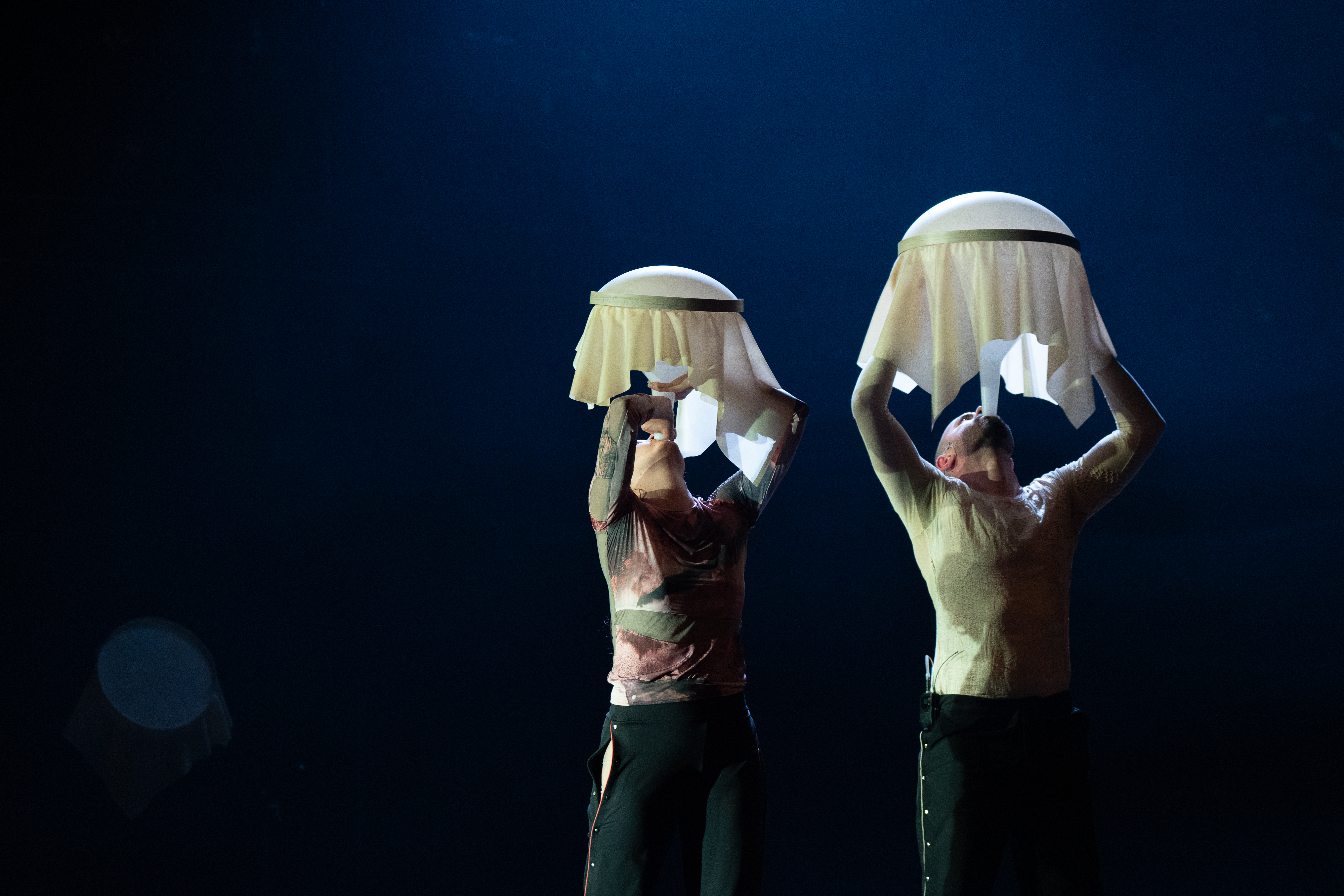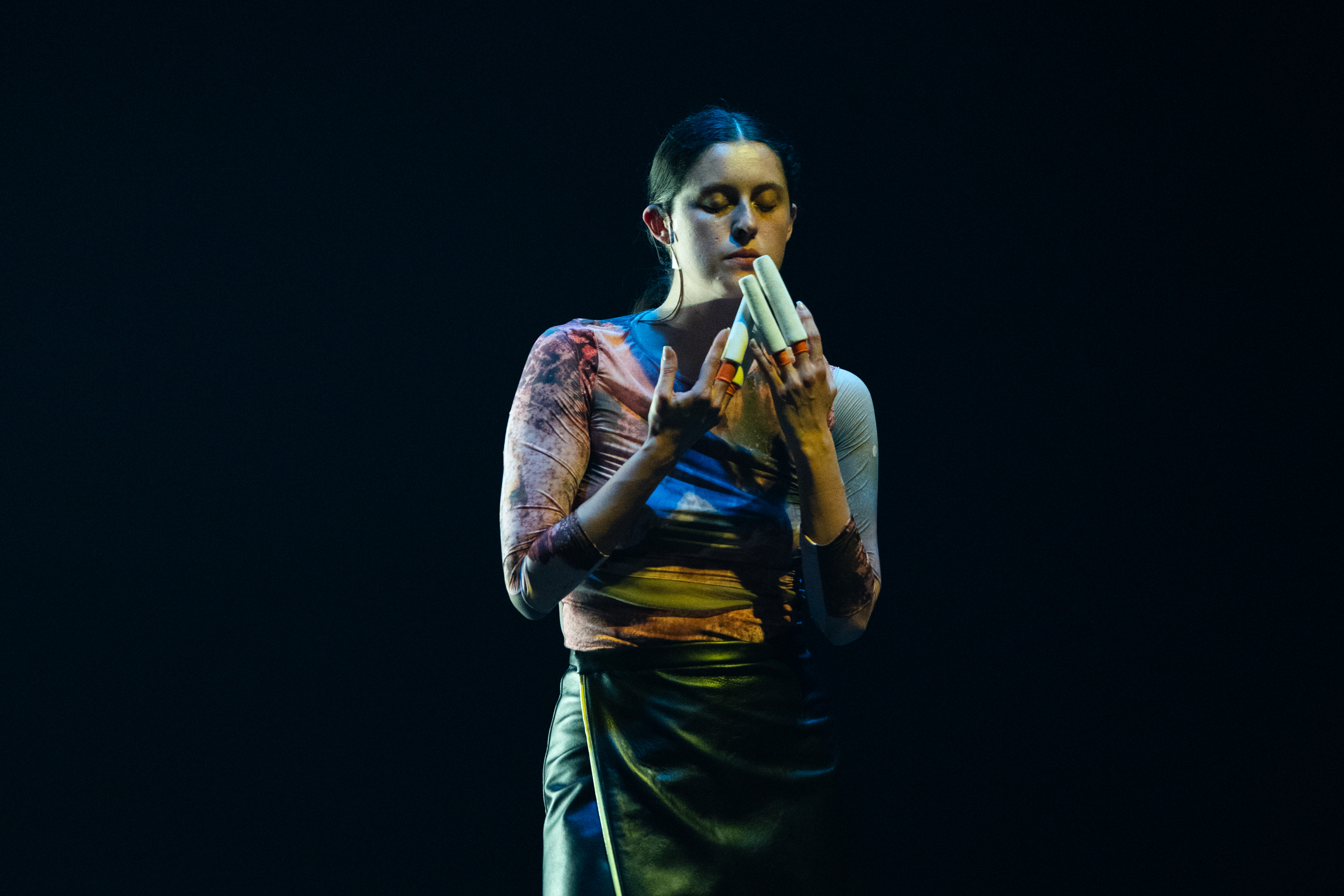Luísa Saraiva
Bocarra
- 20.11 — 21.11 2025
- Performances
- Centro Cultural de Belém - Black Box
- €13 (See discounts)
- ages 12+
- 1H
- In Portuguese and Spanish
Voice, movement and sound resonate through space and bodies as living matter of resistance.
Bocarra — a word meaning an oversized or wide-open mouth — draws on the female polyphonic singing repertoire from northern Portugal and Galicia, where songs speak of bitterness and evoke brutal violence against women. These voices — in shouts or whispers, ritualised or fragmented — emerge as gestures of non-conformity and resistance.
On stage, three performers sing, move and engage with a collection of original sound objects. Made of stone, ceramic, plastic or metal, these handcrafted instruments act as extensions of the internal organs and breath, activated by air, friction and touch, until the body itself becomes a soundscape.
Structured like a concert, where each song takes the lead, Bocarra composes a vocal and sensorial choreography in which bodies, transformed into instruments, produce melodic hauntings — cries that echo as forms of resistance.
Luísa Saraiva in conversation with David Cabecinha
Your artistic practice has often revolved around an investigation of the body as a space of resonance and as an instrument. A body that has a voice, that breathes, and that relates to other musical objects. What is the importance of music in your relationship with the body and with dance?
Something that became very clear to me over the years, as I kept developing my work, was the idea of the voice as something that needs movement in order to carry affect. I have a very specific interest in the kind of music production that makes me move. Not something that comes from outside and is external to me, but something that needs to happen at the same time so that both can generate meaning together. It is not about music you dance to, but about the music of the body, the music of the viscera, and the music of the organs. It is about the music that moves you, and why.
How did your encounter with these repertoires of traditional songs come about? How do you see your place of work from within this universe?
I started researching Portuguese traditional music precisely because of that interest in understanding what kind of sound certain bodies produce. Why does my voice fit here? Why are the cadences, chords, and progressions of these songs so intuitive to me? I never lived in a village, I did not learn any of this repertoire through work, yet my voice has the timbre, the colour, and the qualities needed not only to learn it, but to research and transform it.
There is also a personal dimension to it. As we get older, we start thinking not only about the place we come from, but also about the places our parents came from. I started realising that the move my father made, from a village in Serra da Estrela to a city over the course of the 20th century, was probably deeper and more transformative, culturally speaking, than my own move from Porto to Berlin in 2011.
It was also a speculative exercise about those ghosts that are still so recent, that disappeared so quickly, within one generation. What would have happened if they had not disappeared? Maybe that can be the role of the contemporary artist. There is another kind of bodily work possible, the work of dance, the affective work I can explore. It is about who the people were who lived before me and occupied this place, and who I would be if those deep cultural changes had not taken place. It is not so much about what this means in terms of tradition, but about the energy and the musical and bodily baggage we carry.
I find it interesting to think about this possibility of embodying something that does not belong to our own contemporaneity, but from which we can still learn, and which can be transformed, altered, and reinterpreted with contemporary tools.
Or even accessed through them. In Bocarra, when I sing Dona Irene or Henriqueta, they are deeply violent stories. There is a rape, there are very clear expressions of guilt. We know that even if these things take different forms today, they have not disappeared. There is something very moving about singing these repertoires, and also about questioning why they still move me. What experiences underlie them, what ideas of the body and of power are embedded in them?
Regardless of the song’s theme itself, I think what is most interesting is this question of transmission. I am not so interested in the fact that the song might be about a broken marriage promise, for instance, but rather in the affect of that broken promise, of feeling excluded, unchosen, something that has lasted for centuries. What contexts led people to sing these songs in this way? Why did they survive? They open up so many questions that allow for an exercise in speculation.
In these songs, there is also a question of gender, not only because of the names that give rise to the stories being told, about these women, but also because it is a repertoire traditionally sung by women. And yet, in this piece, you decided not to work exclusively with women. On stage, besides you, there is Luisa Alfonso and Alexandre Achour. Why?
Yes, it was a very deliberate decision not to let this research, this embodiment, belong exclusively to or be carried out only by a group of women. Because it is not just about the question of the female voice. I did not want it to become a closed speculation limited to that oral tradition where there were only binary genders. We know perfectly well that these are not issues exclusive to women; they concern those who have less power.
The piece itself is more about the affect of violence, from the perspective of the one who suffers, the one who has no voice. Since all the songs are about women, it was important to me not to restrict it to that identity logic. These women who do not speak, that is the three of us.
This piece premiered in a large auditorium, and now it will be presented in the CCB’s Black Box. How do you think this proximity will change the relationship with the audience?
When you are very far away, you are not directly touched by the vibration of the voice. I feel that the affect and the emotion of how to sing and how to move, which for me are at the core of my creations, will be more present here. That more human side, of being with the people who are performing the piece in the same space, being touched directly by the voices, and being able to perceive what happens to the body.
Lisbon, Berlin
September 2025
Credits
Choreography, Artistic Direction Luísa Saraiva Performance by and with Luisa Alfonso, Alexandre Achour, Luísa Saraiva Instruments Inês Tartaruga Água Sound Design Francisco Antão Light Design Cárin Geada Costumes Isabelle Lange Martial Arts Training Zeina Hanna, Manuel Pérez Bouza Vocal coach Fabíola Augusta External Eye Niklaus Bein Acknowledgements Matthias Mohr, Arnaldo Saraiva Production Associação Calote Esférica and Crybaby GbR Production Management Övgü Özen, Nadine Freisleben /Apricot Productions (Alemanha), Mariana Costa / Associação Calote Esférica (Portugal) Co-production Festival Dias da Dança /Teatro Municipal do Porto, La Manufacture CDCN Nouvelle- Aquitaine, PACT Zollverein Financial support República Portuguesa – Cultura/Direção -Geral das Artes, Ministério da Cultura e Ciência Nordrhein -Westfalen/NRW Landesbüro Freie Darstellende Künste, Kunststiftung NRW Supported by Residências Paraíso, Colectivo RPM
Add to calendar
Download the full Alkantara Festival 2025 programme

Luísa Saraiva is a choreographer and performer born in Porto, Portugal and living between Porto and Berlin. She studied psychology at the University of Porto and dance at the Folkwang Arts University in Essen. Her choreographic work explores the language of the body and voice and lies at the intersection of movement and musical composition. She was selected for the danceWeb scholarship in 2019 and in the season of 2019/2020 she was one of the choreographers-in-residence at the K3 | Tanzplan Hamburg. In 2022/2023 she was a recipient of the Tanzpraxis Scholarship from...











